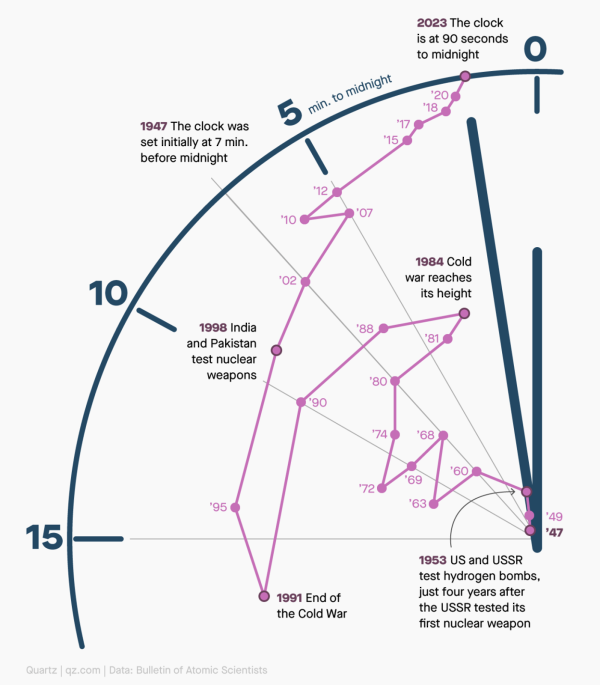There are a number of destabilizing events that make me hope for peace, love, and prosperity. There are increasingly dangerous active military conflicts, a contentious election in front of us, and a host of other issues related to the promise or peril associated with the clash between exponential technologies and human fear, greed, and discretionary mistakes.
With that said, random worry isn't a good strategy. I like to measure subjective things as objectively as possible. With that in mind, this post discusses something called the Doomsday Clock.
The History of the Doomsday Clock
The Doomsday Clock was created by a group of atomic scientists in 1947 (following the successful testing of the first atomic bomb by the United States) to warn the public about the dangers of nuclear weapons. The clock is a metaphor, with midnight representing the catastrophic destruction of the world. The closer the clock is to midnight, the closer humanity is to a global catastrophe.
In 1953, after both the US and Soviet Union tested hydrogen bombs, the clock was set at two minutes to midnight, which is the closest it has ever been to a global catastrophe. In recent years, the clock has taken into account not only nuclear weapons but also climate change and other emerging threats.
The Significance of the Doomsday Clock in Modern Times
Today, the Doomsday Clock remains an important symbol of humanity's vulnerability and the need for urgent action to prevent a global disaster. The clock serves as a reminder that we must work together as a global community to address existential threats facing our planet.
The Bulletin of Atomic Scientists' Science and Security Board determines where to set the clock each year based on international events and scientific advancements. As such, it provides an objective measure of how close we are to destruction.
Nuclear war is still a significant risk, but not the only one. A list of the most significant existential threats to humanity includes:
-
Nuclear War: The threat of atomic weapons and the possibility of a global nuclear war continue to pose a significant risk to humanity.
-
Climate Change: Climate change is a growing threat to humanity and the planet, causing rising sea levels, extreme weather events, and loss of biodiversity.
-
Pandemics: The rapid spread of infectious diseases, such as COVID-19, highlights the vulnerability of the human species to pandemics.
-
Artificial Intelligence: The development of advanced AI systems has the potential to pose existential risks if not adequately regulated and controlled.
-
Biotechnology: The rapid advancement in biotechnology, including genetic engineering and synthetic biology, has the potential to bring about new risks to humanity.
-
Natural Disasters: Natural disasters such as earthquakes, tsunamis, and volcanic eruptions can cause widespread destruction and loss of life.
Some would argue that our exploration of space is another potential threat. So, these are just a few examples, and the list is not exhaustive. Addressing these risks requires a global effort and cooperation between nations, organizations, and individuals.
The Doomsday Clock was initially set at 7 minutes to midnight in 1947. In the 76 years since it launched, the hands have been adjusted 25 times. The most recent change, in 2023, moved the clock from 100 seconds to midnight to 90 seconds. This was a small but significant shift. But, this year, 2024, there was no shift.
Flowing Data put together a chart to show the clock's movement since inception.

via flowingdata
The Doomsday Clock provides a long-term perspective on the dangers facing humanity. Despite the seemingly small number of seconds remaining to midnight, it serves as a reminder of the urgency to act.
And necessity is often the mother of invention.
We can move towards a brighter future by acknowledging the potential consequences of our actions (or inactions). Advancements in fields such as medicine, technology, and human potential offer hope and the potential to overcome even the most pressing challenges.
With collaboration among the brightest minds across the globe and private industry, we can solve even the world's most significant problems.
If I have to choose, I always bet on humanity.
Onwards!

Leave a Reply